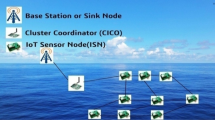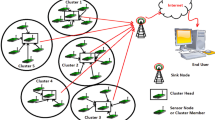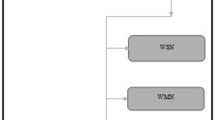Abstract
The field of Underwater Acoustic Sensor Networks (UASNs) is one of the emerging areas of communication due to the number of marine applications. However, UASNs face several fundamental challenges like node movement, high propagation delay, low throughput, high bit-error-rate, low bandwidth, and void-node during communication. Void-node during routing is one of the major problems during routing, which causes high end-to-end delay to route the packets to the sink. The void-node is a fundamental challenge in UASNs and directly influences the UASNs in terms of the end-to-end delay, packet loss, and reliability of the UASNs. The main objective of this paper is to design a void-aware routing protocol referred to as Location-Free Void Avoidance Routing (LFVAR) protocol. It develops void-awareness among nodes in the UASNs and prevents forwarding of the packets to void and trap nodes. Further, LFVAR capable of selecting the efficient void-recovery path for the void-nodes present in the UASNs. Thus, it aims at reducing the end-to-end delay, lower energy consumption, higher packet delivery ratio, and increasing throughput during routing. The LFVAR protocol is implemented in UnetStack and further compared with the state-of-the-art Interference-aware routing (Intar) protocol. The simulation result shows that the packets in LFVAR reach the sink 32.32 % faster, consumes 20.54 % lower energy, and 9.8 % higher packet delivery ratio than Intar.











Similar content being viewed by others
References
Akyildiz, I. F., Pompili, D., & Melodia, T. (2004). Challenges for efficient communication in underwater acoustic sensor networks. ACM Sigbed Review, 1(2), 3–8.
Stojanovic, M., & Preisig, J. (2009). Underwater acoustic communication channels: Propagation models and statistical characterization. IEEE communications magazine, 47(1), 84–89.
Ghoreyshi, S. M., Shahrabi, A., & Boutaleb, T. (2017). Void-handling techniques for routing protocols in underwater sensor networks: Survey and challenges. IEEE Communications Surveys & Tutorials, 19(2), 800–827.
Shetty, S., Pai, R. M., & Pai, M. M. (2018). Energy efficient message priority based routing protocol for aquaculture applications using underwater sensor network. Wireless Personal Communications, 103(2), 1871–1894.
Tzu-Chiang C., Jia-Lin C., Yue-Fu T., Sha-Pai L. (2013) Greedy geographical void routing for wireless sensor networks. In Proceedings of World Academy of Science, Engineering and Technology, World Academy of Science, Engineering and Technology (WASET) (vol. 78, p. 1248).
Kheirabadi, M. T., & Mohamad, M. M. (2013). Greedy routing in underwater acoustic sensor networks: A survey. International Journal of Distributed Sensor Networks, 9(7), 701834.
Javaid, N., Majid, A., Sher, A., Khan, W. Z., & Aalsalem, M. Y. (2018). Avoiding void holes and collisions with reliable and interference-aware routing in underwater wsns. Sensors, 18(9), 3038.
Erol-Kantarci, M., Mouftah, H. T., & Oktug, S. (2011). A survey of architectures and localization techniques for underwater acoustic sensor networks. IEEE Communications Surveys & Tutorials, 13(3), 487–502.
Noh, Y., Lee, U., Wang, P., Choi, B. S. C., & Gerla, M. (2012). VAPR: Void-aware pressure routing for underwater sensor networks. IEEE Transactions on Mobile Computing, 12(5), 895–908.
Xie, P., Zhou, Z., Peng, Z., Cui, J.-H., & Shi, Z. (2009). Void avoidance in three-dimensional mobile underwater sensor networks. Wireless Algorithms, Systems, and Applications (pp. 305–314). Berlin Heidelberg, Berlin, Heidelberg: Springer.
Xie, P., Zhou, Z., Nicolaou, N., See, A., Cui, J.-H., & Shi, Z. (2010). Efficient vector-based forwarding for underwater sensor networks. EURASIP Journal on Wireless Communications and Networking, 1, 195910.
Haitao, Yu. J., & Nianmin Yao, L. (2015). An adaptive routing protocol in underwater sparse acoustic sensor networks. Ad Hoc Networks, 34, 121–143.
Coutinho, R. W. L., Boukerche, A., Vieira, L. F. M., & Loureiro, A. A. F. (2016). Geographic and opportunistic routing for underwater sensor networks. IEEE Transactions on Computers, 65(2), 548–561. https://doi.org/10.1109/TC.2015.2423677
Lee, S., Bhattacharjee, B., & Banerjee, S. (2005). Efficient geographic routing in multihop wireless networks. In Proceedings of the 6th ACM international symposium on Mobile ad hoc networking and computing (pp. 230–241)
Noh, Y., Lee, U., Wang, P., Choi, B. S. C., & Gerla, M. (2013). Vapr: Void-aware pressure routing for underwater sensor networks. IEEE Transactions on Mobile Computing, 12, 895–908.
Ghoreyshi, S. M., Shahrabi, A., & Boutaleb, T. (2015). An inherently void avoidance routing protocol for underwater sensor networks. In 2015 International Symposium on Wireless Communication Systems (ISWCS) (pp. 361–365). https://doi.org/10.1109/ISWCS.2015.7454364
Ghoreyshi, S. M., Shahrabi, A., & Boutaleb, T. (2016). A novel cooperative opportunistic routing scheme for underwater sensor networks. Sensors, 16(3), 297.
Barbeau M., Blouin S., Cervera G., Garcia-Alfaro J., Kranakis E. (2015) Location-free link state routing for underwater acoustic sensor networks. In 2015 IEEE 28th Canadian Conference on Electrical and Computer Engineering (CCECE) (vol. 6, pp. 1544–1549).
Noh, Y., Lee, U., Lee, S., Wang, P., Vieira, L. F. M., Cui, J., Gerla, M., & Kim, K. (2016). Hydrocast: Pressure routing for underwater sensor networks. IEEE Transactions on Vehicular Technology, 65(1), 333–347.
Yu, H., Yao, N., Wang, T., Li, G., Gao, Z., & Tan, G. (2016). WDFAD-DBR: Weighting depth and forwarding area division DBR routing protocol for UASNs. Ad Hoc Networks, 37, 256–282. https://doi.org/10.1016/j.adhoc.2015.08.023, http://www.sciencedirect.com/science/article/pii/S1570870515001894.
Alasarpanahi, H., Ayatollahitafti, V., & Gandomi, A. (2020). Energy-efficient void avoidance geographic routing protocol for underwater sensor networks. International Journal of Communication Systems, 33(6), e4218.
Gola, K. K., & Gupta, B. (2021). Underwater acoustic sensor networks: An energy efficient and void avoidance routing based on grey wolf optimization algorithm. Arabian Journal for Science and Engineering, 46(4), 3939–3954.
Rahman, Z., Hashim, F., Rasid, M. F. A., Othman, M., & Alezabi, K. A. (2020). Normalized advancement based totally opportunistic routing algorithm with void detection and avoiding mechanism for underwater wireless sensor network. IEEE Access, 8, 67484–67500.
Mhemed, R., Comeau, F., Phillips, W., & Aslam, N. (2012). Void avoidance opportunistic routing protocol for underwater wireless sensor networks. Sensors, 21(6), 1942.
Liu, J., Yu, M., Wang, X., Liu, Y., Wei, X., & Cui, J. (2018). RECRP: An underwater reliable energy-efficient cross-layer routing protocol. Sensors, 18(12), 4148.
Akyildiz, I. F., Pompili, D., & Melodia, T. (2005). Underwater acoustic sensor networks: Research challenges. Ad Hoc Networks, 3(3), 257–279.
Coutinho, R. W., Boukerche, A., Vieira, L. F., & Loureiro, A. A. (2015). A novel void node recovery paradigm for long-term underwater sensor networks. Ad Hoc Networks, 34, 144–156.
Melodia T., Pompili D., Akyildiz I. F. (2004) Optimal local topology knowledge for energy efficient geographical routing in sensor networks. In IEEE INFOCOM 2004 (vol. 3, pp. 1705–1716) IEEE.
Chitre M. (2020 (accessed June 24, 2020)a) Underwater networks handbook. https://unetstack.net/handbook/unet-handbook.pdf.
Chitre M. (2020 (accessed June 24, 2020)b) fjage documentation. https://buildmedia.readthedocs.org/media/pdf/fjage/dev/fjage.pdf.
Luo, H., Wu, K., Ruby, R., Hong, F., Guo, Z., & Ni, L. M. (2017). Simulation and experimentation platforms for underwater acoustic sensor networks: Advancements and challenges. ACM Computing Surveys (CSUR), 50(2), 28.
Chitre, M., Bhatnagar, R., & Soh, W.-S. (2014a). Unetstack: An agent-based software stack and simulator for underwater networks. In2014 Oceans-St (pp. 1–10). IEEE: John’s.
Chitre, M., Bhatnagar, R., Ignatius, M., & Suman, S. (2014b). Baseband signal processing with unetstack. In 2014 Underwater Communications and Networking (UComms), (pp. 1–4)
Author information
Authors and Affiliations
Corresponding author
Ethics declarations
Conflict of interest
The authors declare that they have no conflict of interest.
Additional information
Publisher's Note
Springer Nature remains neutral with regard to jurisdictional claims in published maps and institutional affiliations.
The authors thank the Science and Engineering Research Board (SERB), Govt. of India for providing financial support (ref. no. EEQ/2018/001036).
Rights and permissions
About this article
Cite this article
Nazareth, P., Chandavarkar, B.R. Location-Free Void Avoidance Routing Protocol for Underwater Acoustic Sensor Networks. Wireless Pers Commun 123, 575–600 (2022). https://doi.org/10.1007/s11277-021-09147-y
Accepted:
Published:
Issue Date:
DOI: https://doi.org/10.1007/s11277-021-09147-y




